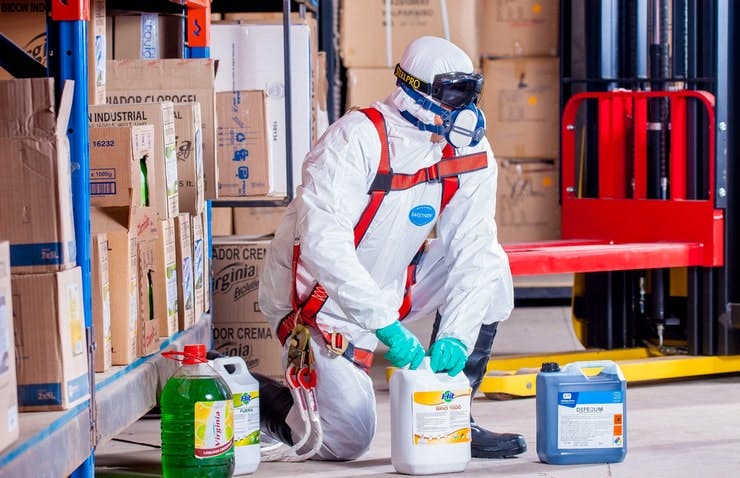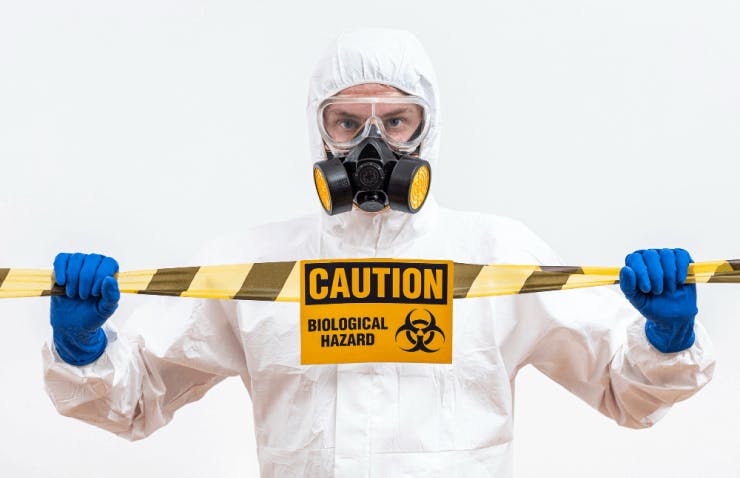10 Hazardous Material Training Courses
We’ve created a list of hazardous material training courses to help employees reduce the risks of working with hazardous materials while also ensuring the safety of those around them. These courses will familiarize them with essential safety information and guidelines needed that they can apply in their day to day jobs.
Last published: 9th June 2025

1. Hazardous Materials (Silica, Polymerics and Waste)
This hazardous materials class by SC Training (formerly EdApp) aims to educate learners about the risks and effects of coming in contact with hazardous materials. Among the topics covered are hazardous waste, polishing & cleaning chemicals, polymeric safety, and crystalline silica exposure. It will teach learners how to prevent risk or reduce exposure to those substances, as well as the proper handling of hazardous materials. They’ll also learn about chemical hygiene practices, such as wearing PPE and using safer alternatives to hazardous materials.
SC Training (formerly EdApp)’s Hazardous Materials course consists of 4 bite-sized lessons that are focused on key concepts about the topic. Following a microlearning design model, the information in this course is easily understood as they’re delivered in a concise, targeted approach, which increases the likelihood of retention. It’s the perfect format for providing critical information to your employees, which makes training more effective.
Cost: Free (up to 10 users)
Scope: Hazardous waste, polymerics safety, silica exposure, polishing & cleaning chemicals
Created by SC Training (formerly EdApp)
Explore this free course
2. Chemical Storage and Handling
SC Training’s Chemical Storage and Handling course equips learners with the knowledge they need to lower their risk of chemical exposure. It highlights the importance of having a Material Safety Data Sheet (MSDS) that provides information on a specific substance and its proper handling procedures. Since chemicals are highly dangerous and explosive, this course will also teach learners about proper storage and safe transportation. As accidents may still happen at work, they’ll also learn what to do in cases of emergency due to chemical exposure which is also stated in the SDS.
Since SC Training is a mobile learning solution, this course can also be taken on smartphones and tablets aside from PCs. It’s perfectly formatted for any device, which means that it’s always responsive and functions seamlessly.
Cost: Free (up to 10 users)
Scope: Working safely with chemicals, Safety Data Sheet requirements, safe storage & transportation of chemicals
Created by SC Training (formerly EdApp)
Explore the course
3. DOT/RCRA Hazardous Waste Training
The general objective of this course is to comply with the Resource Conservation and Recovery Act (RCRA), Department of Transportation (DOT) regulations, and the Hazard Communication Standard. This includes defining waste, identifying waste classifications, and safely managing, storing, or handling hazardous waste.
Here, learners will know all about the safety and occupational health considerations when accumulating hazardous waste and the risks associated with hazardous materials transportation. This course is self-paced but you’ll only have 60 days to complete it. A certificate of completion will be given once all requirements have been met.
Cost: 219 USD
Scope: Defining hazardous waste, RCRA and DOT regulations, safe managing, handling, and storage of hazardous waste
Created by Hazmat School
Explore the course
4. Hazmat: General Awareness Training
This course was designed to educate employees about the Hazardous Materials Regulations (HMR) to help keep everyone safe from hazardous materials. Taking this course will meet the safety training requirement (49 CFR 172.704(a)(3)) as mandated by law. Here, learners will be able to determine if a material is hazardous and identify the properties that make it hazardous.
They will also learn the importance of the Hazmat Table which lists down hazardous materials, their description, and shipping information. This course will teach employees the different ways to communicate hazardous materials by using labelling, markings, and signages.
Cost: 25 USD
Scope: Determining a hazmat, hazard classes & divisions used to identify hazardous materials, Hazmat Table
Created by J.J. Keller
Explore the course
5. Asbestos in General Industry (US)
SC Training (formerly EdApp)'s Asbestos in General Industry (US) course focuses on promoting safety when dealing with asbestos, a naturally occurring substance with soft and flexible fibers that can pose health risks to workers.
This course gives workers a clearer understanding of asbestos. They'll learn to identify asbestos-containing materials and implement proper safety measures to prevent exposure. By following the guidelines of OSHA Standard 1910.1001, the course meets regulatory requirements and has been reviewed by the American Society of Safety Professionals (ASSP) for compliance.
Cost: Free (up to 10 users)
Scope: Introduction to asbestos, hazards of asbestos, hazard reduction measures
Created by SC Training (formerly EdApp)
Explore the courseExplore our library including hazardous material training courses.

6. Lithium Batteries Training by Ground
Batteries are used in almost every electronic device and vehicle but not everyone is aware of the risks related to them. This course is ideal for employees who will be handling, shipping, and/or transporting lithium batteries by ground. Here, learners will be made aware of the current regulations involving the shipping and handling of lithium batteries.
They’ll become familiar with the different types, sizes, and uses of lithium batteries as well as the proper way to label, pack, and store them. They will also know about the emergency response requirements associated with lithium batteries. Overall, this course takes around 4-5 hours to complete and learners can download a certificate of course completion after.
Cost: 179 USD
Scope: Classifying lithium batteries, U.S. and international transport regulations, emergency requirements
Created by Hazmat University
Explore the course
7. Hazard Communication
SC Training’s Hazard Communication course focuses on educating your workforce about the toxicological profile of chemicals and the hazards surrounding them. Here, they will learn more about the physical, environmental, and health hazards associated with these harmful substances, when and how they occur, and the steps your team can take to eliminate or at least reduce these risks.
As they progress through these lessons, they will also gain a thorough understanding of the components of GHS-compliant hazard labels and safety data sheets. This way, they can easily identify the hazards of the chemical products they will be working with as well as the best practices to avoid accidental exposure or any related incidents.
This course only contains 11 short but highly concentrated slides that your team can complete in just 5-10 minutes. If you have remote employees all over the world, this course is perfect to deploy since SC Training's AI translation tool enables you to translate content into different languages, like Spanish, Japanese, or Arabic with just a few clicks.
Cost: Free (up to 10 users)
Scope: Different types of chemical hazards, how and when they occur, steps to eliminate or reduce them, elements of GHS-compliant chemical labels & safety data sheets
Created by SC Training (formerly EdApp)
Explore the course
8. Cadmium Awareness For General Industry
This course by ClickSafety is designed to bring awareness to general industry workers about the adverse effects of cadmium. In this course, learners can expect to know about the properties and uses of Cadmium, OSHA standards, and overall safety measures.
They’ll also be taught to identify the primary means of exposure, such as electroplating and exposed batteries, and will be informed about the signs of exposure to cadmium and how to respond to it. This is an introductory course targeted to beginners and only takes 10 minutes to complete.
Cost: 25 USD
Scope: Introduction to cadmium, properties and exposure to cadmium, OSHA safety requirements
Created by ClickSafety
Explore the course
9. Mercury Awareness Training
This course by Mintra will benefit workers whose jobs involve working with mercury or workplaces where it is present. It will provide learners with fundamental knowledge of the properties of mercury and the safety guidelines to reduce the risk of exposure. This includes hygiene & sanitation steps, use of PPEs, and proper waste management procedures.
This hazardous materials training will also help workers identify the hazards and effects of mercury exposure, first-aid measures, and emergency response actions. You can choose to buy this course with an access period of either 30 days or 1 year.
Cost: Starts at £30
Scope: Properties of mercury, hazards that mercury can present, PPE requirements, emergency response actions
Created by Mintra
Explore the course
10. Heavy Metal Hazards
SC Training (formerly EdApp)’s Heavy Metal Hazards course educates learners about heavy metals by defining them and identifying their benefits and dangers. It explains safety measures around the three most common heavy metals which are arsenic, mercury, and lead. This course discusses the properties of each heavy metal, the different forms they take, and their use cases. You can be assured of the credibility and accuracy of the information in this course as they are sourced from the CDC and OSHA.
This course has four lessons making it easy to complete and comprehend. SC Training (formerly EdApp) also has a quiz maker tool called Rapid Refresh so you can easily check on your employees’ understanding of the topics presented and their level of learning retention. You can input your questions on an easy-to-complete spreadsheet and automatically send them out at regular intervals. Aside from assessing your learners’ knowledge retention, this is also perfect to use for reinforcing key concepts.
Cost: Free (up to 10 users)
Scope: Benefits & dangers of heavy metals, uses & forms of heavy metals, arsenic, lead, and mercury safety
Created by SC Training (formerly EdApp)
Explore the courseProtect your health at work with hazardous material training
Hazardous materials, or hazmat, pose serious health risks, such as skin damage, organ damage, and cancer, to those who work with them or have them present in their workplace. This is why equipping workers with the knowledge and skills about these substances is beneficial to avoid any illnesses or injuries on the job. Not only is it important to train your employees about hazardous materials but it’s also a requirement by the law to protect everyone from the dangers they can present.